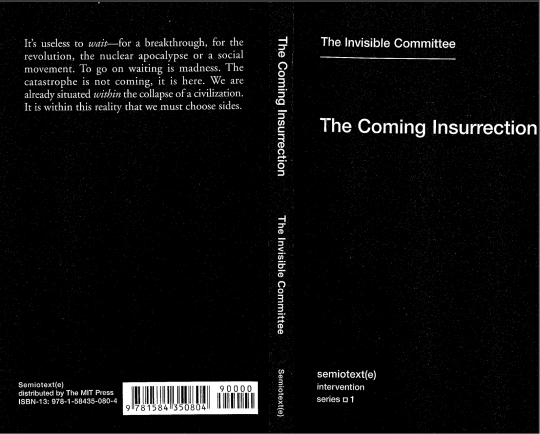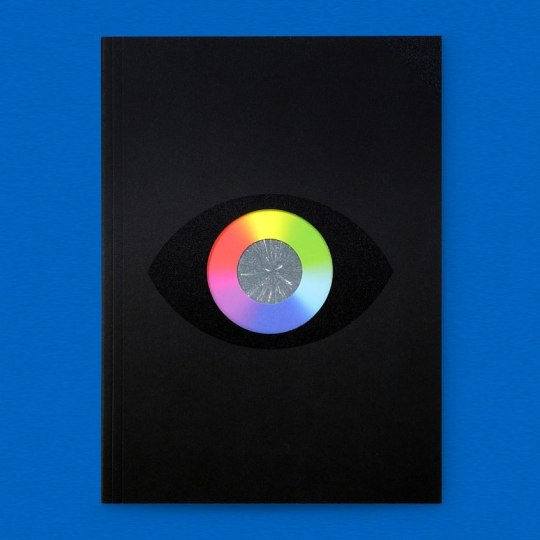#gary zhexi zhang
Text
Listed: Fortunato Durutti Marinetti

Beginning with 2020’s Desire, a self-released cassette, Toronto-based, Turin-born Daniel Colussi, has explored his “poetic jazz rock” (Colussi’s own apt coinage) across three releases under the moniker Fortunato Durutti Marinetti. The instrumentals flow and waver: now flashes of synthesizer keys or strings; now an inquisitive, lightly warped guitar line — the music floats then jumps but never rushes. His vocals — and lyrics — recall stated 1970s influences like Lou Reed or a spoken-word Robert Wyatt, but also Leonard Cohen or, more contemporarily, Destroyer’s Dan Bejar. Alex Johnson found Colussi’s latest release, Eight Waves In Search Of An Ocean, “engrossing — although not always comfortably…a record that rewards the delayering effect of multiple listens.”
Gary Zhexi Zhang — “The Tourist”
Zhang’s documentary ostensibly tells the story of Ali Sultan Issa, who led Zanzibar’s independence from Britain in 1963. Issa is a totally fascinating and complicated Zelig-like figure who seemed to be present for every revolutionary moment in the middle of the century. He hung out with Castro, Mao and also the CIA. I can’t believe how effectively and delicately Zhang is able to tell what a massive story about empire is — de-colonization, the optimism of mid-twentieth century socialist movements and the brutal 80s neoliberal response. This film also introduced me to the song “Super Snooper”by 1970s Italo disco crew La Bionda.
Annette Peacock — Unsung Heroine
A 12-minute doc on Annette Peacock circa 2000, as she recorded with a string quartet in Oslo for ECM. It’s not the most celebrated era of her career, but An Acrobat’s Heart is an interesting album of smoldering baroque torch songs. There’s great-to-see footage of her walking around Oslo in leather pants and also, it’s great to hear her speaking voice, which has that classic US drawl of an artist who’s lived through decades of chaos.
DJ Voices — Hemlock Nights @ Honcho Campout 2023
When NYC’s DJ Voices came to Toronto last summer my crew and I danced our asses off all night long. It was a good night and I’m glad it happened.
Lou Sheppard with Pamela Hart — Rights Of Passage
A beautiful, smart record that uses the metaphor of a river’s legal right to flow (riparian rights) to talk about property vs. public space, control of and access to resources and forms of enclosure. The record is also about queerness, and how queerness is or is not permitted to exist within particular defined spaces. This record is technically a sister artifact to Lou’s video/sound installation at the Art Gallery of York University, but it works totally well on its own as a gorgeous LP.
Ed Gray — Different Drummer : Elvin Jones
youtube
1979 documentary on Elvin Jones — a weird period for him. I think like most people, I know him primarily through his 1960s albums with John Coltrane. This doc has beautiful footage of Elvin hanging out with his family in the backyard as well as him in the studio describing his relationship to the cymbals in terms of different colors — chromesthesia. I also like his sleazy late 70s style — white leather loafers, a mesh shirt and a cigarette dangling as he absolutely shreds on his kit.
Elvis Presley — Unchained Melody (Rapid City June 21, 1977)
youtube
An insane document of Elvis in the very final throes of his imperial era. His banter is barely intelligible. Coca Cola cups scattered everywhere. Everyone in the band is sweaty and hairy. Wide bellbottoms all around. A middle-aged stagehand (who Elvis refers to as “son”) awkwardly holds the mic up to Elvis. Rising out of all this confusion, Elvis begins an extremely personal rendition of this Righteous Brothers song. There are pregnant pauses, as if he loses his place in the song, and there is no consistent tempo until the band kicks in, at which point all of Rapid City levitates into outer space. And two months later, Elvis was dead.
The Invisible Committee — The Coming Insurrection

In his Dusted review of my album, Alex Johnson singled out the words and language in my song “Smash Your Head Against The Wall.” When I think back to writing that song, I think of reading The Invisible Committee’s The Coming Insurrection. Their language is totally polemic and fiery and outrageous, but purposely and with intent. Oftentimes they’re playing with that caricatured idea of “the radical left.” Not everyone appreciates this approach: apparently it freaked out US neocon broadcaster Glenn Beck enough that he warned his followers about this book’s evil. My copy has many underlined passages that I return to again and again for guidance and inspiration.
Bruford — Back To The Beginning (Rock Goes To College, March 17th, 1979)
youtube
Annette Peacock’s second appearance on this list — too much? In this performance she casually strolls into the Bruford zone to provide some female levity to this otherwise brutally nervous and sweaty prog rock crew. There’s a strong argument that this song sucks because it suffers from that thing of prog/jazz virtuosos trying to play basic heavy rock and failing because they’re too good. But I think it’s awesome, especially when Annette lets her raincoat theatrically drop to the floor to indicate that she has officially assumed control of the proceedings.
Joni Mitchell — In France They Kiss On Main Street (Santa Barbara Bowl, 1979)
youtube
I like this era because it captures Joni just as she’s really alienating the majority of her audience by desecrating her folk-rock legacy via fully embracing smoothed out jazz fusion tones. She’s playing with a squad of absolute rippers: Metheny, Pastorius, Lyle Mays, Michael Brecker and Don Alias. Everyone is at the top of their game; everyone is in the zone. I like this ferocious live version of this song better than the studio version.
Tindersticks — The Ballad of Tindersticks (2 Meter Sessions, June 7, 1997)
youtube
For me Tindersticks are a deep well of inspiration, to which I can continually return for sustenance, guidance and nourishing refreshment. I love it all: the early baroque albums, the mid period soul albums, the soundtracks, the solo records. I think their last record was phenomenal. They are masters of subtly adjusting their songwriting as a way of unlocking vast new territories to explore. They make it all their own. I pick this particular clip because I like how the entire band is sweating profusely.
#dusted magazine#listed#daniel colussi#fortunato durutti marinetti#gary zhexi zhang#annette peacock#dj voices#lou sheppard#pamela hart#ed gray#elvin jones#elvis presley#the invisible committee#bruford#joni mitchell#tindersticks
2 notes
·
View notes
Text
WISLW BUMPER PACK!
i write a lil culture diary for twp blog, called ✨What I Saw Last Week✨ — rather than do the thing where i post them individually, i am j gna dump em all here in one big bundle along with the descriptions so u know what’s in them
8th jan: lots of films! the green knight, triangle of sadness, only lovers left alive, the wonderful story of henry sugar, medusa deluxe
29th jan: rob auton @ soho theatre, chess night @ reference point, ART ON THE UNDERGROUND X JOY GREGORY X UNIQLO!, kingdom of heaven (director's cut), gattaca, bits & bobs!!! (started a new teaching job, lecture @ chelsea college of art, in convo with Art Assassins @ SLG, free palestine)
5th feb: dark with excessive bright @ royal ballet, real estate (by deborah levy)
12th feb: three rooms (by jo hamya), bad taste (by nathalie olah), the road to wigan pier (by george orwell), the kiss (by anton chekhov), the favourite
19th feb: boy parts (by eliza clark), past lives, did a talk at UEL!
26th feb: hackney museum, Gary Zhexi Zhang lecture @ ICA, il prato by the taviani brothers @ BFI, tate reading room, stickers
11th mar: dune 2, american fiction, daunt books festival, TWP TIKTOK!?!
18th mar: slavoj zizek & ash sarkar, london feeds itself 2 book launch, maz murray, principle boy @ focal point gallery
ok!!! now you're up to date! those are all the WISLWs from this year and i'm actually very proud of myself -- one my many, many new years resolutions was to be more consistent with it and i am doing a GOOD JOB and i feel satisfied by the outcome! it's such a nice quick easy way to write and its such a handy reference, good exercise, limbering up etc. there u go -- i will post them individually from here on out :)
0 notes
Photo

JUST ADDED! Eye on Design, Issue #06 (Utopias) Available at www.draw-down.com Guest-designed by Na Kim The sixth issue of AIGA's Eye on Design focuses on utopias, exploring the elusive concept of idealism in its many forms. The issue looks back at the origins of Modernism and the concept of a universal solution, while also looking to the future to envision how education, labor, the environment, and art might benefit from big, optimistic, and critical ideas. Hear stories about the present moment, and learn about designers who are actively working towards creating a better world. Visit reclusive cartoonist Seth and what might be his most remarkable project to date: his home; discover the rise and fall of Vaporwave, the internet's native aesthetic; and glean tips on how to be a "responsible" designers during the climate change era. Also included: an in-depth conversation with publishing collective One of My Kind; a detailed account of Cooper Union's tuition fight and how it bred a generation of student activists; double die-cuts; Mindy Seu's Cyberfeminist Index; and an illustrated guide to women-run utopias. Contributors include Na Kim, Anoushka Khandwala, Neo Maditla, Louisa Prado de O. Martins and Pedro Oliveira, Zachary Petit, Gary Zhexi Zhang, Ritupriya Basu, Mindy Seu, Louise Benson, Grace Gelder, Max Guther, Yuanchen Jiang, and Stefanie Leinhos. #graphicdesign #design #nakim #eyeondesign (at Berlin, Germany) https://www.instagram.com/p/B6qIuSEHtPT/?igshid=1nzpv121j8vkc
6 notes
·
View notes
Quote
What does it mean to build decentralized systems that sit so comfortably within the regime of contemporary capitalism? We have cause to believe in technological progress, but if our systems are flawed, then the systems we imagine cannot be merely conducive to the power structures in which we’re enmeshed — attending to business as usual, albeit ever more efficiently. ‘All is well since all grows better,’ reflected the industrialist Andrew Carnegie, happily inspired by Spencer’s evolutionist thought. Uncritically, the seductive power of the systems approach seems to reveal an intricate map that affirms the ‘nature of things’ as the way they ought to be — a conservative tendency that must be resisted. As the feminist collective Laboria Cuboniks declare in their ‘Xenofeminist’ manifesto, ‘if nature is unjust, change nature!’.
Gary Zhexi Zhang, Systems Seduction: The Aesthetics of Decentralisation
3 notes
·
View notes
Photo

Save the date! @transmediale Symposium This is Not Anarchy, This is Chaos 28.01 – 29.01 Thankful to be part of this along with my amiga cósmica @patrixdominguez And happy to see other dear friends on the program Gracias @noraomurchu and all the Transmediale team for the work and ❤️🔥 Livestream on transmediale.de No se lo pierda! Day 1: Adam Bobbette, Antonia Hernández, Bassam El Baroni, Bassem Saad, Che Applewhaite, Distributed Cognition Cooperative (Anna Engelhardt, Sasha Shestakova), Donal Lally, Imani Jaqueline Brown, MELT (Ren Loren Britton & Isabel Paehr), Nishant Shah, Paolo Gerbaudo, Robert Gerard Pietrusko, Phanuel Antwi, Sabine Gruffat, Xenia Chiaramonte, Zach Blas Day 2: Ahmed Isamaldin, AM Kanngieser, Bahar Noorizadeh, Cindy Kaiying Lin, Dele Adeyemo, Elaine Gan, Elsa Brès, Gary Zhexi Zhang, Jack Halberstam, Magda Tyżlik-Carver, Mary Maggic, Maya Indira Ganesh, Max Haiven, Olúfẹ́mi O. Táíwò, Patricia Domínguez and Nicole L'Huillier, Samir Bhowmik, Timothée Parrique https://www.instagram.com/p/CZJ0tq_OCny/?utm_medium=tumblr
1 note
·
View note
Video
vimeo
Sinofuturism (1839 - 2046 AD)
"Sino-Futurism is an invisible movement. A spectre already embedded into a trillion industrial products, a billion individuals, and a million veiled narratives. It is a movement, not based on individuals, but on multiple overlapping flows. Flows of populations, of products, and of processes. Because Sinofuturism has arisen without conscious intention or authorship, it is often mistaken for contemporary China. But it is not. It is a science fiction that already exists."
Sinofuturism is a video essay combining elements of science fiction, documentary melodrama, social realism, and Chinese cosmologies, in order to critique the present-day dilemmas of China and the people of its diaspora.
With reference to Afrofuturism and Gulf Futurism, Sinofuturism presents a critical and playful approach to subverting cultural clichés.
In Western media and Orientalist perceptions, China is exotic, strange, bizarre, kitsch, tacky, or cheap. In its domestic media, China portrayed as heroic, stable, historic, grand, and unified. Rather than counteract these skewed narratives, Sinofuturism proposes to push them much further.
By embracing seven key stereotypes of Chinese society (Computing, Copying, Gaming, Studying, Addiction, Labour and Gambling), it shows how China's technological development can be seen as a form of Artificial Intelligence.
--
Initially broadcast as part of Radio Study Day at Wysing Arts Centre, 21 August 2016.
Thanks to: Joni Zhu, Steve Goodman, Gary Zhexi Zhang, Deforrest Brown, Samantha Culp, Justin Kim, Stephanie Bailey, AVANT.org, After Us, Film & Video Umbrella, Wysing Arts Centre
2 notes
·
View notes
Video
vimeo
Sinofuturism (1839 - 2046 AD) from Lawrence Lek on Vimeo.
"Sinofuturism is an invisible movement. A spectre already embedded into a trillion industrial products, a billion individuals, and a million veiled narratives. It is a movement, not based on individuals, but on multiple overlapping flows. Flows of populations, of products, and of processes. Because Sinofuturism has arisen without conscious intention or authorship, it is often mistaken for contemporary China. But it is not. It is a science fiction that already exists.
Sinofuturism is a video essay combining elements of science fiction, documentary melodrama, social realism, and Chinese cosmologies, in order to critique the present-day dilemmas of China and the people of its diaspora.
With reference to Afrofuturism and Gulf Futurism, Sinofuturism presents a critical and playful approach to subverting cultural clichés.
In Western media and Orientalist perceptions, China is exotic, strange, bizarre, kitsch, tacky, or cheap. In its domestic media, China portrayed as heroic, stable, historic, grand, and unified. Rather than counteract these skewed narratives, Sinofuturism proposes to push them much further.
By embracing seven key stereotypes of Chinese society (Computing, Copying, Gaming, Studying, Addiction, Labour and Gambling), it shows how China's technological development can be seen as a form of Artificial Intelligence."
--
Initially broadcast as part of Radio Study Day at Wysing Arts Centre, 21 August 2016.
Thanks to: Joni Zhu, Steve Goodman, Gary Zhexi Zhang, Deforrest Brown, Samantha Culp, Justin Kim, Stephanie Bailey, Alvin Li, AVANT.org, After Us, Film & Video Umbrella, UCCA, Wysing Arts Centre
Chinese Subtitles by Wenfei Wang for 'The New Normal', an exhibition at UCCA, Beijing.
0 notes
Text
Writers/Curators Digital Art
1. Joanne Mcneil - independent/
2. Jon Ippolito -
3. Christiane Paul - Whitney/
4. Lev Manovich -
5. Patrick Lichty -
6. Mark Tribe - Rhizome.org/
7. David Quiles Guillo - The Wrong Biennale
8. Nora O Murchu - writer/curator
9. Luigina Ciolfi - Human/Computer interaction
10. Tina Sauerlaender - Curator and Writer - digital and internet culture
11. Faith Holland - Curator,
12. Michael Borras a.k.a Systaime
13. Kelani Nichole - Transfer Gallery
14. Zoe Salditch
15. Gene Mchugh - night.house
16. Jennifer Chan - artist/writer
17. Attilia Fattori Franchini
18. DIS Magazine
19. Omar Kholeif
20. Judy Ditner
21. Nadim Samman
22. Bonaventure Soh Beijing Ndikung
23. Hanne Mugaas
24. Courtney Malick
25. Nora N. Khan *
26. Nicholas O’brien
27. Melissa Loughnan
28. Orit Gat *
29. Lindsay Howard *
30. Sarah Cook, Dundee, Neon sarahcook.info
31. Gary Zhexi Zhang
32. Keith J. Varadi
33. Nicholas O’Brien [digital art]
34. Alex Gartenfeld
35. Domenico Quaranta
36. Jon Davies
37. Lalin Akalan
39. Kim Stewart [Glasgow]
40. Diana Poulsen
41. Jason Eppink [Curator of Digital Media at MOMI]
42. Omar Kholeif
0 notes
Video
vimeo
Sinofuturism (1839 - 2046 AD) from Lawrence Lek on Vimeo.
"Sinofuturism is an invisible movement. A spectre already embedded into a trillion industrial products, a billion individuals, and a million veiled narratives. It is a movement, not based on individuals, but on multiple overlapping flows. Flows of populations, of products, and of processes. Because Sinofuturism has arisen without conscious intention or authorship, it is often mistaken for contemporary China. But it is not. It is a science fiction that already exists.
Sinofuturism is a video essay combining elements of science fiction, documentary melodrama, social realism, and Chinese cosmologies, in order to critique the present-day dilemmas of China and the people of its diaspora.
With reference to Afrofuturism and Gulf Futurism, Sinofuturism presents a critical and playful approach to subverting cultural clichés.
In Western media and Orientalist perceptions, China is exotic, strange, bizarre, kitsch, tacky, or cheap. In its domestic media, China portrayed as heroic, stable, historic, grand, and unified. Rather than counteract these skewed narratives, Sinofuturism proposes to push them much further.
By embracing seven key stereotypes of Chinese society (Computing, Copying, Gaming, Studying, Addiction, Labour and Gambling), it shows how China's technological development can be seen as a form of Artificial Intelligence."
--
Initially broadcast as part of Radio Study Day at Wysing Arts Centre, 21 August 2016.
Thanks to: Joni Zhu, Steve Goodman, Gary Zhexi Zhang, Deforrest Brown, Samantha Culp, Justin Kim, Stephanie Bailey, Alvin Li, AVANT.org, After Us, Film & Video Umbrella, UCCA, Wysing Arts Centre
Chinese Subtitles by Wenfei Wang for 'The New Normal', an exhibition at UCCA, Beijing.
0 notes
Video
vimeo
Geomancer
Chapter 3: Archaeology of the Future
Extract for Transmediale 2018 // Face Value
Geomancer is a CGI film by Lawrence Lek about the creative awakening of artificial intelligence. On the eve of Singapore's 2065 Centennial, an adolescent satellite AI escapes its imminent demise by coming down to Earth, hoping to fulfil its dream of becoming the first AI artist. Faced with a world that limits its freedom, Geomancer must come to terms with its militarised origins, a search that begins with a mysterious syndicate known as the Sinofuturists...
Featuring HD video game graphics, a neural network-generated dream sequence, and a synthesised vocal soundtrack, Geomancer explores the implications of post-human consciousness.
--
jerwoodvisualarts.org/projects/jerwoodfvu-awards-2017-neither-one-thing-another
Press Release: fvu.co.uk/projects/geomancer
--
CREDITS
Geomancer by Lawrence Lek
Executive Producer - Steven Bode, FVU
Production Managers - Ilona Sagar & Polly Wright, FVU
Production Supervisor - Susanna Chisholm, FVU
Animation - Clifford Sage
Architecture - Johnny Lui
World Design - Lawrence Lek
AI-Generated Footage - Terence Broad
Music - Lawrence Lek
Sound Design - Seth Scott
Written & Edited by Lawrence Lek
Script Advisor - Ned Beauman
Voice of Geomancer - Joni Zhu
Voice of Dealer - Jennifer Ka Yan Lam
Voice of Master Rui - Xiaoyi Nie
Voice of Master Wu - Gary Zhexi Zhang
Mandarin Translator - Joni Zhu
Cantonese Translator - Jennifer Ka Yan Lam
Production Accountant - Sophie Luard, FVU
Production Insurance - Integro Entertainment
Special Thanks To
Oliver Fuke, Jerwood Visual Arts
Sarah Williams, Jerwood Charitable Foundation
Alix Taylor
Commissioned for the Jerwood/FVU Awards 2017: Neither One Thing Or Another
A Collaboration between Jerwood Charitable Foundation and FVU
FVU is supported by Arts Council England
© Lawrence Lek 2017
0 notes
Text
SOME READING
Ascott, Roy,
(1999) Reframing consciousness. Exeter, England: Intellect.
Bertol, Daniela,
Designing Digital Space — An Architect’s Guide to Virtual Reality, John Wiley & Sons, Inc. (1997)
Bishop, Claire.
(2005) Installation art. New York: Routledge.
Bishop, Claire.
(ed.) (2008) Participation. Cambridge, MA: Whitechapel.
Bostrom, Nick.
(2014) "Get ready for the dawn of superintelligence", New Scientist, 223(2976), pp. 26-27. doi: 10.1016/s0262-4079(14)61304-x.
Crowther, Paul A.
(1993) Art and embodiment: From aesthetics to self-consciousness. 2nd edn. Oxford: Oxford University Press.
Davies, Char,
(1999) Reframing consciousness. ‘Ephémère: Landscape,Earth, Body and Time in Immersive Virtual Space’ Exeter, England: Intellect. PP, 196-201
Davies.E
(1996) ‘Wired, Magazine’
DATE OF PUBLICATION: 08.01.96 vol 4-08
https://www.wired.com/tag/magazine-4-08/
Descartes, Rene,
Ouevres de Descartes, 11 vols., eds. Charles Adam and Paul Tannery, Paris: Vrin, 1974-1989.
Descartes, Rene,
The Philosophical Writings of Descartes, 3 vols., trans. John Cottingham, Robert Stoothoff, Dugald Murdoch and Anthony Kenny, Cambridge: Cambridge University Press, 1984-1991
Dolinsky. Margaret,
(1999) ‘Reframing consciousness’. Exeter, England: Intellect.
‘Virtual Environment ad Rebus’ PP: 201-205
Fukuyama, Francis.
(2002) Our posthuman future. New York: Farrar, Straus and Giroux.
Fieser, James,
Great Issues in Philosophy Home: www.utm.edu/staff/jfieser/120 Copyright 2008, updated 1/1/2015
Grau, Oliver,
Virtual Art — From Illusion to Immersion, The MIT Press (2003)
Holler, Carsten
(2005) Interviewed by Vincent Honoré for Tate: http://www.tate.org.uk/whats-on/tate-modern/exhibition/unilever-series-carsten-holler-test-site/carsten-holler-interview
Johnson, Steven.
(2016) Want to Know What Virtual Reality Might Become? Look to the Past, Nytimes.com. Available at: http://www.nytimes.com/2016/11/06/magazine/want-to-know-what-virtual-reality-might-become-look-to-the-past.html?smid=fb-share&_r=0 (Accessed: 4 November 2016).
Kabakov, Ilya & Emilia.
(2005) An Alternative History Of Art. Edited by Emilia Kabakov. Bielefeld: Kerber.
Lyotard, Jean-Francois.
(1991) The inhuman. Cambridge: Polity Press,
Massumi, Brian,
From ‘Hypersurface Architecture’
edited by Stephen Perrella,
Architectural Design (Profile no. 133), vol. 68, no. 5/6, May-June 1998, pp. 16-24
McCullough, Malcolm,
Abstracting Craft — The Practiced Digital Hand, The MIT Press (1998)
McCullough, Malcolm,
Digital Ground — Architecture, Pervasive Computing and Environmental Knowing, The MIT Press (2004)
McLuhan, M.y Parker, H.
(1969). Through the Vanishing Point: Space in Poetry and Painting. New York: Harper & Row.
Morgan, Jessica,
(2006) Parkett no. 77: Trisha Donnelly, Carsten holler, Rudolf Stingel. United States: Parkett Publishers.
Narby, Jeremy.
(1998) The cosmic serpent. New York: Jeremy P. Tarcher/Putnam
Planke, Max,
Quoted in The Observer (25 Jan 1931). Cited in Joseph H. Fussell, 'Where is Science Going?: Review and Comment', Theosophical Path Magazine, January to December 1933 (2003), 199.
Rafman.John,
(2014) interviewed by Gabriel H. Sanchez for ‘Art Forum-500 words’ https://www.artforum.com/words/id=47380
Rist.Pipilotti
Southbank Centre (2011) Pipilotti Rist in conversation. Available at: https://www.youtube.com/watch?v=uKR-QhjOz-o (Accessed: 4 January 2017).
Robins, Kevin
(2000) ‘Cyberspace and the world we live in’ in Bell, D & Kennedy, B (Eds) The Cybercultures Reader. London: Routledge. PP: 77-80.
Roman, Mathilde
(2016) On stage: The theatrical dimension of video image. United Kingdom: Intellect Books.
Zindell, David.
(1988) Neverness. New York: D.I. Fine.
Zhang, Gary Zhexi.
(2016) Infinite Lives (Frieze). Available at: http://www.jonrafman.com/Frieze_Jan2016pp92-97.pdf (Accessed: 25 November 2016)
0 notes
Quote
Today, technological wealth produced by and for society largely oils the machinery of capitalist accumulation. While we have yet to witness the decentralization of control, the collective wealth produced by of the decentralization of production — that is, the ‘sharing economy’, the big data industry, and other platforms that monetize our daily social interactions — remains firmly in the service of exploitative (centralized) corporations. Whether in logistics or social media, it is not so difficult — nor even particularly radical — to imagine decentralized, peer-to-peer services which produce value by and for the commonwealth. Nonetheless, it would require governance, by nationalization or other means: the network is not identical to the commons, and nor should we hope for it to be.
Gary Zhexi Zhang, Systems Seduction: The Aesthetics of Decentralisation
6 notes
·
View notes
Link
The meteoric rise of Ed Atkins in the last couple of years is a testament to the artist’s prodigious talent, but also the contemporaneity of his concerns, both aesthetic and philosophical. The digital existentialism of his trademark CGI avatars offers our reflection through a black mirror which is at once flawless and flaccid, a pathetic hero to encapsulate the psychological texture of a world as isolating and perplexing as it is seductive.
For this year’s Manchester International Festival, Atkins has scaled up his operation. Where past works were charged with the misanthropic intimacy of the lone artist performing to webcam, Performance Capture, turns three rooms of the Manchester Art Gallery into a studio into a factory. The press blurb tells us that Atkins is ‘lifting the veil’ on his high-gloss digital process. Conceived with outgoing festival director Alex Poots and ubiquitous art-person Hans-Ulrich Obrist, the exhibition comprises a vast motion capture studio, a monolith of networked computers, and a screening room. MIF participants are recorded reading from the artist’s poem-script using a 3D camera and the motion capture software Faceshift. The production pipeline leads us on past a cluster of a dozen 3D animators, busily smoothing, sculpting and compositing the footage, turning freshly plotted co-ordinates into a sleek digital avatar. All this gets thrust through the bowels of the render farm, the great enteric machine from which the rushes of the day emerge for visitors to watch in the cinema space. The eventual film will combine these performance captures into a single avatar, a schizoid ambassador for the faces and voices who brought you this year’s festival.
0 notes
Video
vimeo
Sinofuturism (1839 - 2046 AD) from Lawrence Lek on Vimeo.
"Sino-Futurism is an invisible movement. A spectre already embedded into a trillion industrial products, a billion individuals, and a million veiled narratives. It is a movement, not based on individuals, but on multiple overlapping flows. Flows of populations, of products, and of processes. Because Sinofuturism has arisen without conscious intention or authorship, it is often mistaken for contemporary China. But it is not. It is a science fiction that already exists."
Sinofuturism is a video essay combining elements of science fiction, documentary melodrama, social realism, and Chinese cosmologies, in order to critique the present-day dilemmas of China and the people of its diaspora.
With reference to Afrofuturism and Gulf Futurism, Sinofuturism presents a critical and playful approach to subverting cultural clichés.
In Western media and Orientalist perceptions, China is exotic, strange, bizarre, kitsch, tacky, or cheap. In its domestic media, China portrayed as heroic, stable, historic, grand, and unified. Rather than counteract these skewed narratives, Sinofuturism proposes to push them much further.
By embracing seven key stereotypes of Chinese society (Computing, Copying, Gaming, Studying, Addiction, Labour and Gambling), it shows how China's technological development can be seen as a form of Artificial Intelligence.
--
Initially broadcast as part of Radio Study Day at Wysing Arts Centre, 21 August 2016.
Thanks to: Joni Zhu, Steve Goodman, Gary Zhexi Zhang, Deforrest Brown, Samantha Culp, Justin Kim, Stephanie Bailey, AVANT.org, After Us, Film & Video Umbrella, Wysing Arts Centre
0 notes

